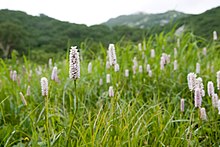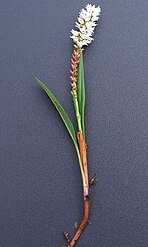| Bistorta | |
|---|---|

| |
| Bistorta officinalis in Japan | |
|
Scientific classification
| |
| Kingdom: | Plantae |
| Clade: | Tracheophytes |
| Clade: | Angiosperms |
| Clade: | Eudicots |
| Order: | Caryophyllales |
| Family: | Polygonaceae |
| Subfamily: | Polygonoideae |
| Genus: |
Bistorta (L.) Scop. [1] |
| Synonyms [1] | |
| |
Bistorta is a genus of flowering plants in the family Polygonaceae. As of February 2019 [update] about 40 species are accepted. It has been supported as a separate clade by molecular phylogenetic analysis. [2] Bistorta species are native throughout much of the Northern Hemisphere, as far south as Mexico in North America and Thailand in Asia. [1]
Description
Species of Bistorta are perennial herbaceous plants. Their roots are fibrous, forming rhizomes. They have erect, unbranched stems. Their leaves are usually longer than wide, mostly basal, but with some arranged alternately on the stems. The inflorescences are spikelike. The individual flowers have five white to purple-pink (rarely red) tepals. The flowers are bisexual, although the 5–8 stamens are sometimes poorly developed. There are three styles. The fruits are in the form of achenes, that are brown or dark brown, unwinged, and three-angled. The monoploid number of chromosomes, x, is 11 or 12. [3]
Taxonomy
In 1753, Carl Linnaeus divided up his genus Polygonum into unranked groups, one of which was Bistorta. In 1754, Giovanni Antonio Scopoli elevated Bistorta to a genus. [4]
Bistorta is placed in the subfamily Polygonoideae, tribe Persicarieae, along with the genera Koenigia and Persicaria. A 2015 molecular phylogenetic study suggested that the tribes in Polygonoideae were related as shown in the following cladogram. [5]
| Polygonoideae |
| ||||||||||||||||||||||||||||||||||||
Within the tribe Persicarieae, Bistorta is most closely related to Koenigia: [5]
| Persicarieae |
| ||||||||||||
Species
As of March 2019 [update], Plants of the World Online accepted the following 42 species. [1]
- Bistorta abukumensis Yonek., Iketsu & H.Ohashi
- Bistorta affinis (D.Don) Greene
- Bistorta albiflora Miyam. & H.Ohba
- Bistorta alopecuroides (Turcz. ex Besser) Kom.
- Bistorta amplexicaulis (D.Don) Greene
- Bistorta attenuata Kom.
- Bistorta attenuatifolia Miyam. & H.Ohba
- Bistorta bistortoides (Pursh) Small
- Bistorta burmanica Yonek. & H.Ohashi
- Bistorta coriacea (Sam.) Yonek. & H.Ohashi
- Bistorta diopetes H.Ohba & S.Akiyama
- Bistorta elliptica (Willd. ex Spreng.) V.V.Petrovsky, D.F.Murray & Elven
- Bistorta emodi (Meisn.) H.Hara
- Bistorta griersonii Yonek. & H.Ohashi
- Bistorta griffithii (Hook.f.) Grierson
- Bistorta hayachinensis (Makino) H.Gross
- Bistorta honanensis (H.W.Kung) Yonek. & H.Ohashi
- Bistorta incana (Nakai) Nakai
- Bistorta jaljalensis H.Ohba & S.Akiyama
- Bistorta krascheninnikovii N.A.Ivanova
- Bistorta longispicata Yonek. & H.Ohashi
- Bistorta ludlowii Yonek. & H.Ohashi
- Bistorta macrophylla (D.Don) Soják
- Bistorta manshuriensis (Petrov ex Kom.) Kom.
- Bistorta milletii H.Lév.
- Bistorta milletioides H.Ohba & S.Akiyama
- Bistorta ochotensis Kom.
- Bistorta officinalis Delarbre
- Bistorta paleacea (Wall. ex Hook.f.) Yonek. & H.Ohashi
- Bistorta perpusilla (Hook.f.) Greene
- Bistorta plumosa (Small) Greene
- Bistorta purpureonervosa (A.J.Li) Yonek. & H.Ohashi
- Bistorta × rhaetica (Brügger) Dostál
- Bistorta rubra Yonek. & H.Ohashi
- Bistorta sherei H.Ohba & S.Akiyama
- Bistorta sinomontana (Sam.) Miyam.
- Bistorta subscaposa (Diels) Petrov
- Bistorta suffulta (Maxim.) Greene ex H.Gross
- Bistorta tenuicaulis (Bisset & S.Moore) Nakai
- Bistorta tenuifolia (H.W.Kung) Miyam. & H.Ohba
- Bistorta tubistipulis Miyam. & H.Ohba
- Bistorta vacciniifolia (Wall. ex Meisn.) Greene
- Bistorta vivipara (L.) Delarbre
References
- ^ a b c d "Bistorta (L.) Scop". Plants of the World Online. Royal Botanic Gardens, Kew. Retrieved 2019-03-01.
- ^ Sanchez, A.; Schuster, T.M. & Kron, K.A. (2009). "A large-scale phylogeny of Polygonaceae based on molecular data". International Journal of Plant Sciences. 170 (8): 1044–1055. doi: 10.1086/605121. S2CID 84694521.
- ^ Freeman, Craig C. & Hinds, Harold R. "Bistorta". In Flora of North America Editorial Committee (ed.). Flora of North America (online). eFloras.org. Retrieved 2019-03-14.
- ^ "Plant Name Details for Bistorta (L.) Scop". The International Plant Names Index. Retrieved 2019-03-11.
- ^ a b Schuster, Tanja M.; Reveal, James L.; Bayly, Michael J. & Kron, Kathleen A. (2015). "An updated molecular phylogeny of Polygonoideae (Polygonaceae): Relationships of Oxygonum, Pteroxygonum, and Rumex, and a new circumscription of Koenigia". Taxon. 64 (6): 1188–1208. doi: 10.12705/646.5.





